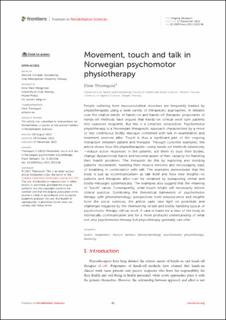| dc.contributor.author | Thornquist, Eline | |
| dc.date.accessioned | 2023-03-22T11:46:29Z | |
| dc.date.available | 2023-03-22T11:46:29Z | |
| dc.date.created | 2023-01-03T10:58:38Z | |
| dc.date.issued | 2022 | |
| dc.identifier.citation | Frontiers in Rehabilitation Sciences. 2022, 3 . | en_US |
| dc.identifier.issn | 2673-6861 | |
| dc.identifier.uri | https://hdl.handle.net/11250/3059813 | |
| dc.description.abstract | People suffering from musculoskeletal disorders are frequently treated by physiotherapists using a wide variety of therapeutic approaches. In debates over the relative merits of hands-on and hands-off therapies, proponents of hands-off methods have argued that hands-on clinical work turn patients into «passive» recipients. But this is a simplistic proposition. Psychomotor physiotherapy is a Norwegian therapeutic approach characterized by a more or less continuous bodily dialogue combined with talk in examination and treatment sessions alike. Touch is thus a significant part of the ongoing interaction between patient and therapist. Through concrete examples, the article shows how the physiotherapists—using hands-on methods extensively—induce active responses in the patients, aid them to trust their bodies, change dysfunctional habits and become aware of their capacity for handling their health problems. The therapists do this by exploring and molding patients' movements, handling their muscle tensions and encouraging ways of breathing in combination with talk. The examples demonstrate that the body is just as «communicative» as talk itself and how new insights—to patients and therapists alike—can be obtained by juxtaposing verbal and bodily messages systematically. The examples also suggest that the meaning of “touch” varies. Consequently, what touch entails will necessarily inform clinical practice. Combining the theoretical framework of psychomotor therapy with phenomenology, perspectives from neuroscience and insights from the social sciences, the article casts new light on potentials and challenges triggered by the intertwining of talk and bodily handling typical of psychomotor therapy clinical work. A case is made for a view of the body as intrinsically communicative and for a more profound understanding of what not only psychomotor therapy but physiotherapy generally can offer. | en_US |
| dc.language.iso | eng | en_US |
| dc.publisher | Frontiers Media | en_US |
| dc.rights | Navngivelse 4.0 Internasjonal | * |
| dc.rights.uri | http://creativecommons.org/licenses/by/4.0/deed.no | * |
| dc.title | Movement, touch and talk in Norwegian psychomotor physiotherapy | en_US |
| dc.title.alternative | Movement, touch and talk in Norwegian psychomotor physiotherapy | en_US |
| dc.type | Peer reviewed | en_US |
| dc.type | Journal article | en_US |
| dc.description.version | publishedVersion | en_US |
| dc.rights.holder | © 2022 Thornquist | en_US |
| dc.source.pagenumber | 16 | en_US |
| dc.source.volume | 3 | en_US |
| dc.source.journal | Frontiers in Rehabilitation Sciences | en_US |
| dc.identifier.doi | 10.3389/fresc.2022.1011146 | |
| dc.identifier.cristin | 2099458 | |
| cristin.ispublished | true | |
| cristin.fulltext | original | |
| cristin.qualitycode | 1 | |

